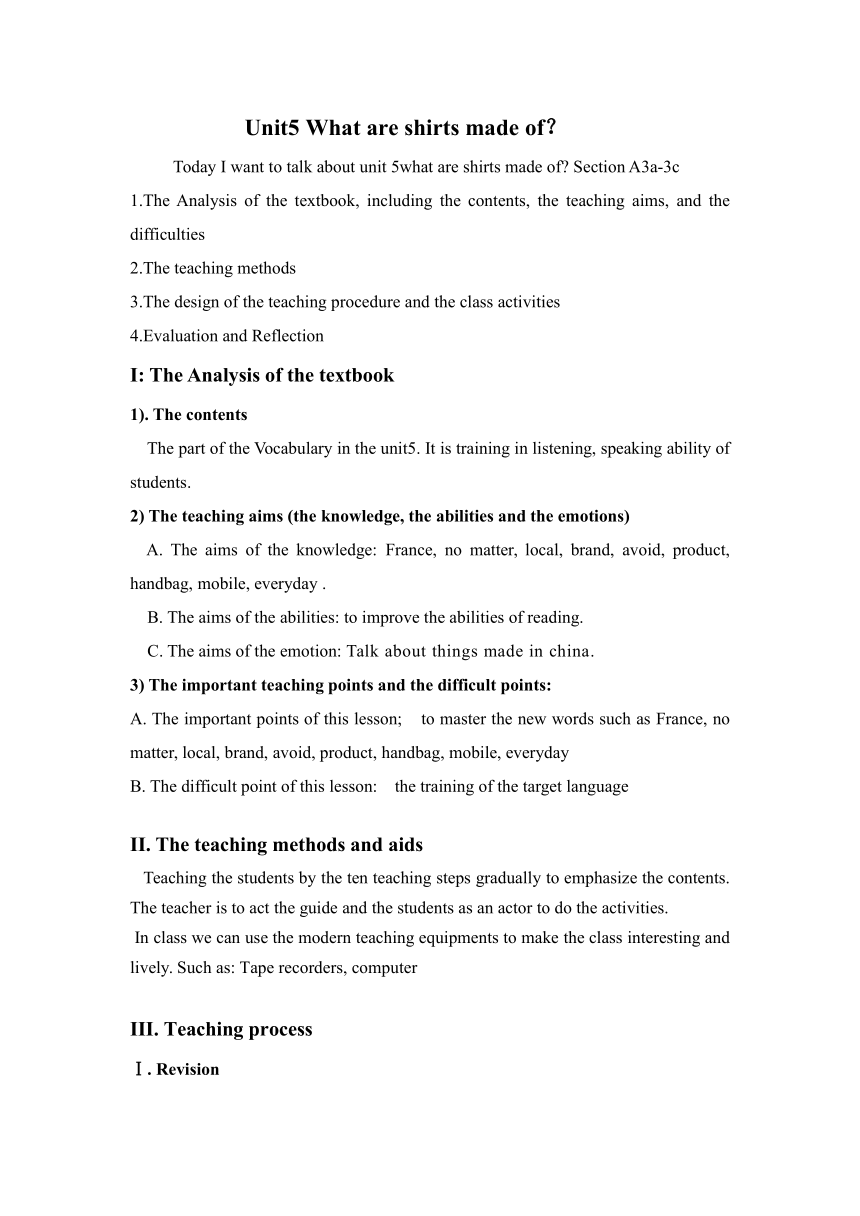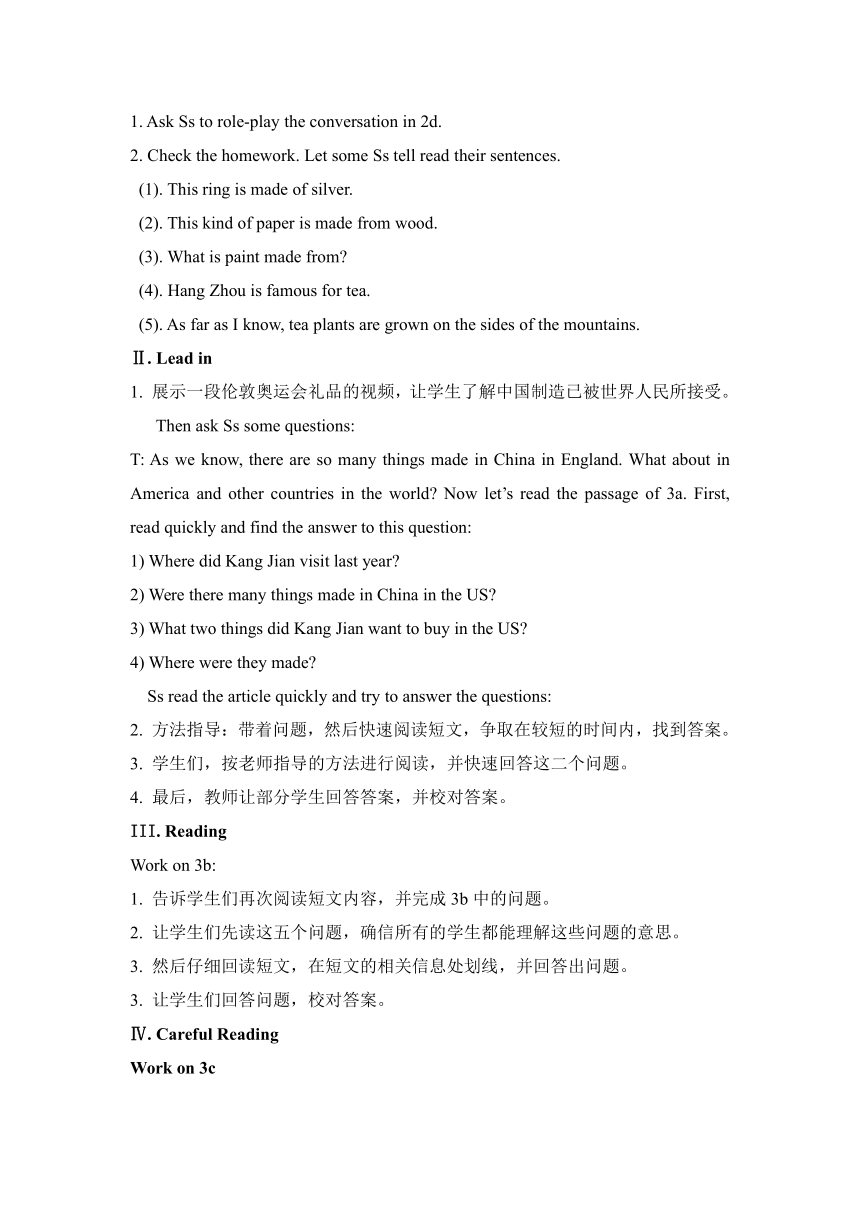人教版英语九全nit 5 What are the shirts made of?SectionA(3a-3c)教案
文档属性
| 名称 | 人教版英语九全nit 5 What are the shirts made of?SectionA(3a-3c)教案 |  | |
| 格式 | doc | ||
| 文件大小 | 32.0KB | ||
| 资源类型 | 教案 | ||
| 版本资源 | 人教新目标(Go for it)版 | ||
| 科目 | 英语 | ||
| 更新时间 | 2022-06-28 22:36:49 | ||
图片预览


文档简介
Unit5 What are shirts made of?
Today I want to talk about unit 5what are shirts made of Section A3a-3c
1.The Analysis of the textbook, including the contents, the teaching aims, and the difficulties
2.The teaching methods
3.The design of the teaching procedure and the class activities
4.Evaluation and Reflection
I: The Analysis of the textbook
1). The contents
The part of the Vocabulary in the unit5. It is training in listening, speaking ability of students.
2) The teaching aims (the knowledge, the abilities and the emotions)
A. The aims of the knowledge: France, no matter, local, brand, avoid, product, handbag, mobile, everyday .
B. The aims of the abilities: to improve the abilities of reading.
C. The aims of the emotion: Talk about things made in china.
3) The important teaching points and the difficult points:
A. The important points of this lesson; to master the new words such as France, no matter, local, brand, avoid, product, handbag, mobile, everyday
B. The difficult point of this lesson: the training of the target language
II. The teaching methods and aids
Teaching the students by the ten teaching steps gradually to emphasize the contents. The teacher is to act the guide and the students as an actor to do the activities.
In class we can use the modern teaching equipments to make the class interesting and lively. Such as: Tape recorders, computer
III. Teaching process
Ⅰ. Revision
1. Ask Ss to role-play the conversation in 2d.
2. Check the homework. Let some Ss tell read their sentences.
(1). This ring is made of silver.
(2). This kind of paper is made from wood.
(3). What is paint made from
(4). Hang Zhou is famous for tea.
(5). As far as I know, tea plants are grown on the sides of the mountains.
Ⅱ. Lead in
1. 展示一段伦敦奥运会礼品的视频,让学生了解中国制造已被世界人民所接受。
Then ask Ss some questions:
T: As we know, there are so many things made in China in England. What about in America and other countries in the world Now let’s read the passage of 3a. First, read quickly and find the answer to this question:
1) Where did Kang Jian visit last year
2) Were there many things made in China in the US
3) What two things did Kang Jian want to buy in the US
4) Where were they made
Ss read the article quickly and try to answer the questions:
2. 方法指导:带着问题,然后快速阅读短文,争取在较短的时间内,找到答案。
3. 学生们,按老师指导的方法进行阅读,并快速回答这二个问题。
4. 最后,教师让部分学生回答答案,并校对答案。
III. Reading
Work on 3b:
1. 告诉学生们再次阅读短文内容,并完成3b中的问题。
2. 让学生们先读这五个问题,确信所有的学生都能理解这些问题的意思。
3. 然后仔细回读短文,在短文的相关信息处划线,并回答出问题。
3. 让学生们回答问题,校对答案。
Ⅳ. Careful Reading
Work on 3c
1. 告诉学生们本学习活动的要求:写出下列指示代词在短文所指代的事物。
2. 让学生们读3d中的内容,理解黑体指示代词所处的句子的意思,及其上下文的意思,开动自己大脑进行思维,确定它们所指的内容。
3. 如果不能确定,可以在小组内进行讨论。
4. Check the answers.
V. Post reading
Ask Ss to fill in the blanks to complete the passage.
Kang Jian is a ____________ student from Shanghai. Last year he went to visit his aunt and uncle in San Francisco. He ______ it interesting that so many _________ in the local shops ______________ China. She wanted to buy a _________ for his cousin, but even though most of the toys were _______ brands, they were made in ________.
Read the second paragraph and fill in the blanks.
Toys are not the only things made in China. ______, there were many other things made in China--footballs, handbags, pet food, mobile phones. Even ______________ are made in China. He ________that Americans could_______ ______ ______ products made in China.
He thinks it’s great that China is so good at ________ these _________ _________. He wishes that China will also get better at making ________________ __________ in the future. And people can buy those products in ______ ______ of the world.
Ss try to fill in the blanks by themselves.
Check the answers with the Ss.
VI. Explanations
1. no matter 无论;不论
no matter意为“无论”与“what, who, which, where, how”等疑问词连用,引导让步状语从句。
e.g. No matter what you say, I won’t believe you.
No matter when you are free, you can come here for a cup of tea.
2. local adj. 当地的;本地的
e.g. The local people are always friendly to tourists. 当地人对游客一向很热情。
3. avoid v. 避免;回避 avoid doing sth. 避免做某事
avoid 后面常跟名词、代词或动名词作宾语,但不能跟不定式作宾语。
e.g. They tried to avoid making Mrs. Li angry. 他们尽量避免让李老师生气。
Jack kept back his anger and avoided a fight.
杰克压住了怒火,避免了一场斗殴。
4. mobile adj. 可移动的;非固定的 mobile phone 手机
e.g. Would you please give us some details of your mobile phone
你能给我们一些你的手机的细节吗?
5. everyday adj. 每天的;日常的
everyday是every和day构成的合成词。everyday是形容词, 仅用在名词前作定语,不能单独使用。 e.g. everyday life日常生活everyday activities 日常活动
everyday与every day 辨析
every day是副词短语,意为“每天”,用作时间状语。
e.g. The teacher asked us to read English books every day.
老师让我们每天都要读英语。
VII. Exercises 用括号中单词的适当形式填空
1. One who goes to ______ (French) never fails to visit Paris.
2. How soon would you like to have these ___________ (product) done
3. In the crowd, Sam looked aside to avoid _________ (see) Jane and Mary.
4. Is this kind of bicycle______ (make) in Shanghai
5. The ______ (locally) government listed him as an elderly person of no home.
Homework
1. Read the passage several times after school.
2. Make sentences with these words:
no matter, be made in, find it + adj. that…, even though, avoid doing sth., everyday things
Today I want to talk about unit 5what are shirts made of Section A3a-3c
1.The Analysis of the textbook, including the contents, the teaching aims, and the difficulties
2.The teaching methods
3.The design of the teaching procedure and the class activities
4.Evaluation and Reflection
I: The Analysis of the textbook
1). The contents
The part of the Vocabulary in the unit5. It is training in listening, speaking ability of students.
2) The teaching aims (the knowledge, the abilities and the emotions)
A. The aims of the knowledge: France, no matter, local, brand, avoid, product, handbag, mobile, everyday .
B. The aims of the abilities: to improve the abilities of reading.
C. The aims of the emotion: Talk about things made in china.
3) The important teaching points and the difficult points:
A. The important points of this lesson; to master the new words such as France, no matter, local, brand, avoid, product, handbag, mobile, everyday
B. The difficult point of this lesson: the training of the target language
II. The teaching methods and aids
Teaching the students by the ten teaching steps gradually to emphasize the contents. The teacher is to act the guide and the students as an actor to do the activities.
In class we can use the modern teaching equipments to make the class interesting and lively. Such as: Tape recorders, computer
III. Teaching process
Ⅰ. Revision
1. Ask Ss to role-play the conversation in 2d.
2. Check the homework. Let some Ss tell read their sentences.
(1). This ring is made of silver.
(2). This kind of paper is made from wood.
(3). What is paint made from
(4). Hang Zhou is famous for tea.
(5). As far as I know, tea plants are grown on the sides of the mountains.
Ⅱ. Lead in
1. 展示一段伦敦奥运会礼品的视频,让学生了解中国制造已被世界人民所接受。
Then ask Ss some questions:
T: As we know, there are so many things made in China in England. What about in America and other countries in the world Now let’s read the passage of 3a. First, read quickly and find the answer to this question:
1) Where did Kang Jian visit last year
2) Were there many things made in China in the US
3) What two things did Kang Jian want to buy in the US
4) Where were they made
Ss read the article quickly and try to answer the questions:
2. 方法指导:带着问题,然后快速阅读短文,争取在较短的时间内,找到答案。
3. 学生们,按老师指导的方法进行阅读,并快速回答这二个问题。
4. 最后,教师让部分学生回答答案,并校对答案。
III. Reading
Work on 3b:
1. 告诉学生们再次阅读短文内容,并完成3b中的问题。
2. 让学生们先读这五个问题,确信所有的学生都能理解这些问题的意思。
3. 然后仔细回读短文,在短文的相关信息处划线,并回答出问题。
3. 让学生们回答问题,校对答案。
Ⅳ. Careful Reading
Work on 3c
1. 告诉学生们本学习活动的要求:写出下列指示代词在短文所指代的事物。
2. 让学生们读3d中的内容,理解黑体指示代词所处的句子的意思,及其上下文的意思,开动自己大脑进行思维,确定它们所指的内容。
3. 如果不能确定,可以在小组内进行讨论。
4. Check the answers.
V. Post reading
Ask Ss to fill in the blanks to complete the passage.
Kang Jian is a ____________ student from Shanghai. Last year he went to visit his aunt and uncle in San Francisco. He ______ it interesting that so many _________ in the local shops ______________ China. She wanted to buy a _________ for his cousin, but even though most of the toys were _______ brands, they were made in ________.
Read the second paragraph and fill in the blanks.
Toys are not the only things made in China. ______, there were many other things made in China--footballs, handbags, pet food, mobile phones. Even ______________ are made in China. He ________that Americans could_______ ______ ______ products made in China.
He thinks it’s great that China is so good at ________ these _________ _________. He wishes that China will also get better at making ________________ __________ in the future. And people can buy those products in ______ ______ of the world.
Ss try to fill in the blanks by themselves.
Check the answers with the Ss.
VI. Explanations
1. no matter 无论;不论
no matter意为“无论”与“what, who, which, where, how”等疑问词连用,引导让步状语从句。
e.g. No matter what you say, I won’t believe you.
No matter when you are free, you can come here for a cup of tea.
2. local adj. 当地的;本地的
e.g. The local people are always friendly to tourists. 当地人对游客一向很热情。
3. avoid v. 避免;回避 avoid doing sth. 避免做某事
avoid 后面常跟名词、代词或动名词作宾语,但不能跟不定式作宾语。
e.g. They tried to avoid making Mrs. Li angry. 他们尽量避免让李老师生气。
Jack kept back his anger and avoided a fight.
杰克压住了怒火,避免了一场斗殴。
4. mobile adj. 可移动的;非固定的 mobile phone 手机
e.g. Would you please give us some details of your mobile phone
你能给我们一些你的手机的细节吗?
5. everyday adj. 每天的;日常的
everyday是every和day构成的合成词。everyday是形容词, 仅用在名词前作定语,不能单独使用。 e.g. everyday life日常生活everyday activities 日常活动
everyday与every day 辨析
every day是副词短语,意为“每天”,用作时间状语。
e.g. The teacher asked us to read English books every day.
老师让我们每天都要读英语。
VII. Exercises 用括号中单词的适当形式填空
1. One who goes to ______ (French) never fails to visit Paris.
2. How soon would you like to have these ___________ (product) done
3. In the crowd, Sam looked aside to avoid _________ (see) Jane and Mary.
4. Is this kind of bicycle______ (make) in Shanghai
5. The ______ (locally) government listed him as an elderly person of no home.
Homework
1. Read the passage several times after school.
2. Make sentences with these words:
no matter, be made in, find it + adj. that…, even though, avoid doing sth., everyday things
同课章节目录
- Unit 1 How can we become good learners.
- Section A
- Section B
- Unit 2 I think that mooncakes are delicious!
- Section A
- Section B
- Unit 3 Could you please tell me where the restroom
- Section A
- Section B
- Unit 4 I used to be afraid of the dark.
- Section A
- Section B
- Unit 5 What are the shirts made of?
- Section A
- Section B
- Review of Units 1-5
- Unit 6 When was it invented?
- Section A
- Section B
- Unit 7 Teenagers should be allowed to choose their
- Section A
- Section B
- Unit 8 It must belong to Carla.
- Section A
- Section B
- Unit 9 I like music that I can dance to.
- Section A
- Section B
- Unit 10 You're supposed to shake hands.
- Section A
- Section B
- Review of Units 6-10
- Unit 11 Sad movies make me cry.
- Section A
- Section B
- Unit 12 Life is full of the unexpected
- Section A
- Section B
- Unit 13 We're trying to save the earth!
- Section A
- Section B
- Unit 14 I remember meeting all of you in Grade 7.
- Section A
- Section B
- Review of Units 11-14
